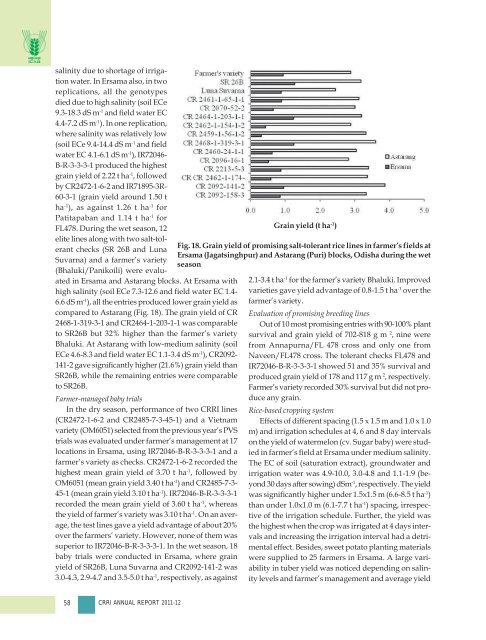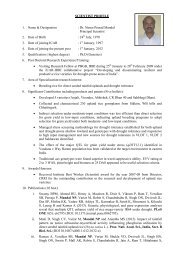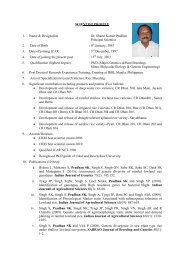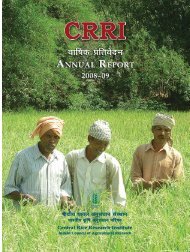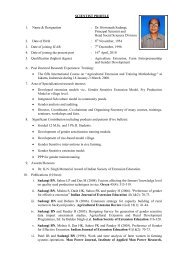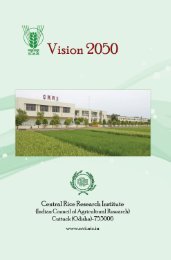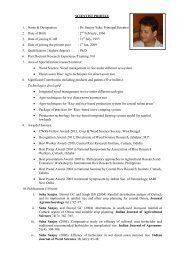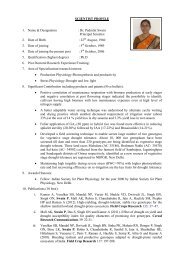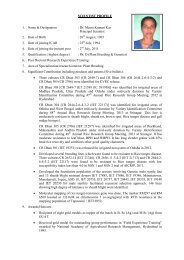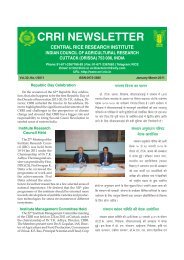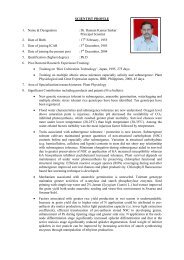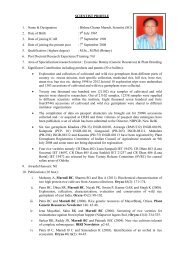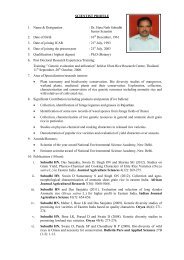Central Rice Research Institute Annual report...2011-12
Central Rice Research Institute Annual report...2011-12
Central Rice Research Institute Annual report...2011-12
You also want an ePaper? Increase the reach of your titles
YUMPU automatically turns print PDFs into web optimized ePapers that Google loves.
salinity due to shortage of irrigation<br />
water. In Ersama also, in two<br />
replications, all the genotypes<br />
died due to high salinity (soil ECe<br />
9.3-18.3 dS m -1 and field water EC<br />
4.4-7.2 dS m -1 ). In one replication,<br />
where salinity was relatively low<br />
(soil ECe 9.4-14.4 dS m -1 and field<br />
water EC 4.1-6.1 dS m -1 ), IR72046-<br />
B-R-3-3-3-1 produced the highest<br />
grain yield of 2.22 t ha -1 , followed<br />
by CR2472-1-6-2 and IR71895-3R-<br />
60-3-1 (grain yield around 1.50 t<br />
ha -1 ), as against 1.26 t ha -1 for<br />
Patitapaban and 1.14 t ha -1 for<br />
FL478. During the wet season, <strong>12</strong><br />
elite lines along with two salt-tolerant<br />
checks (SR 26B and Luna<br />
Suvarna) and a farmer’s variety<br />
(Bhaluki/Panikoili) were evaluated<br />
in Ersama and Astarang blocks. At Ersama with<br />
high salinity (soil ECe 7.3-<strong>12</strong>.6 and field water EC 1.4-<br />
6.6 dS m -1 ), all the entries produced lower grain yield as<br />
compared to Astarang (Fig. 18). The grain yield of CR<br />
2468-1-319-3-1 and CR2464-1-203-1-1 was comparable<br />
to SR26B but 32% higher than the farmer’s variety<br />
Bhaluki. At Astarang with low-medium salinity (soil<br />
ECe 4.6-8.3 and field water EC 1.1-3.4 dS m -1 ), CR2092-<br />
141-2 gave significantly higher (21.6%) grain yield than<br />
SR26B, while the remaining entries were comparable<br />
to SR26B.<br />
Farmer-managed baby trials<br />
In the dry season, performance of two CRRI lines<br />
(CR2472-1-6-2 and CR2485-7-3-45-1) and a Vietnam<br />
variety (OM6051) selected from the previous year’s PVS<br />
trials was evaluated under farmer’s management at 17<br />
locations in Ersama, using IR72046-B-R-3-3-3-1 and a<br />
farmer’s variety as checks. CR2472-1-6-2 recorded the<br />
highest mean grain yield of 3.70 t ha -1 , followed by<br />
OM6051 (mean grain yield 3.40 t ha -1 ) and CR2485-7-3-<br />
45-1 (mean grain yield 3.10 t ha -1 ). IR72046-B-R-3-3-3-1<br />
recorded the mean grain yield of 3.60 t ha -1 , whereas<br />
the yield of farmer’s variety was 3.10 t ha -1 . On an average,<br />
the test lines gave a yield advantage of about 20%<br />
over the farmers’ variety. However, none of them was<br />
superior to IR72046-B-R-3-3-3-1. In the wet season, 18<br />
baby trials were conducted in Ersama, where grain<br />
yield of SR26B, Luna Suvarna and CR2092-141-2 was<br />
3.0-4.3, 2.9-4.7 and 3.5-5.0 t ha -1 , respectively, as against<br />
Grain yield (t ha -1 )<br />
Fig. 18. Grain yield of promising salt-tolerant rice lines in farmer’s fields at<br />
Ersama (Jagatsinghpur) and Astarang (Puri) blocks, Odisha during the wet<br />
season<br />
2.1-3.4 t ha -1 for the farmer’s variety Bhaluki. Improved<br />
varieties gave yield advantage of 0.8-1.5 t ha -1 over the<br />
farmer’s variety.<br />
Evaluation of promising breeding lines<br />
Out of 10 most promising entries with 90-100% plant<br />
survival and grain yield of 702-818 g m 2 , nine were<br />
from Annapurna/FL 478 cross and only one from<br />
Naveen/FL478 cross. The tolerant checks FL478 and<br />
IR72046-B-R-3-3-3-1 showed 51 and 35% survival and<br />
produced grain yield of 178 and 117 g m 2 , respectively.<br />
Farmer’s variety recorded 30% survival but did not produce<br />
any grain.<br />
<strong>Rice</strong>-based cropping system<br />
Effects of different spacing (1.5 x 1.5 m and 1.0 x 1.0<br />
m) and irrigation schedules at 4, 6 and 8 day intervals<br />
on the yield of watermelon (cv. Sugar baby) were studied<br />
in farmer’s field at Ersama under medium salinity.<br />
The EC of soil (saturation extract), groundwater and<br />
irrigation water was 4.9-10.0, 3.0-4.8 and 1.1-1.9 (beyond<br />
30 days after sowing) dSm -1 , respectively. The yield<br />
was significantly higher under 1.5x1.5 m (6.6-8.5 t ha -1 )<br />
than under 1.0x1.0 m (6.1-7.7 t ha -1 ) spacing, irrespective<br />
of the irrigation schedule. Further, the yield was<br />
the highest when the crop was irrigated at 4 days intervals<br />
and increasing the irrigation interval had a detrimental<br />
effect. Besides, sweet potato planting materials<br />
were supplied to 25 farmers in Ersama. A large variability<br />
in tuber yield was noticed depending on salinity<br />
levels and farmer’s management and average yield<br />
58 CRRI ANNUAL REPORT 2011-<strong>12</strong>


